How To Start A Dropshipping Business In 2024 (Step-By-Step)

Are you interested in learning how to start a dropshipping business?
The dropshipping business model is a form of ecommerce in which a third party, known as a “dropshipping supplier” stores inventory of products, then processes and fulfills orders on your behalf.
They even handle customer returns.
It’s a cheaper way to start an ecommerce store, and in this post, we’re going to show you the easiest way to get started.
Let’s get right into it.
How to start a dropshipping business
Here is the step-by-step process we’ll be following on how to start a dropshipping business:
- Understand the entire process of starting a dropshipping business.
- Find your dropshipping niche.
- Conduct market research on your competitors as well as your niche.
- Use the findings in your research to come up with a product idea.
- Choose an ecommerce platform that’s optimized for dropshipping.
- Choose a dropshipping app that’s optimized for the ecommerce platform you choose.
- Start importing your products and getting your ecommerce store ready for launch.
- Take care of typical tasks most businesses need to handle when they first start out.
- Launch your dropshipping business.
Let’s start at the top.
1. Understand the entire process of starting a dropshipping business
Besides this first step that explains the whole process of starting a dropshipping business, we’ve organized the entire process into eight sections.
They range from figuring out which niche you want to target to actually launching your business and optimizing your store as you go.
Let’s briefly cover this process so you know more about what you’re actually doing here.
Dropshipping is a profitable business model and a form of ecommerce in which a service, known as a dropshipping supplier, buys and stocks inventory, processes orders, and ships those orders out to customers on your behalf.
You’re in charge of managing things like choosing which products to sell, creating product pages for them, marketing your business and handling customer service requests.
If you’ve ever started a blog or business in the past, you should already be familiar with the first part of starting a dropshipping business: finding your niche.
Finding a niche will help you conduct market research and identify a specific pain point for a specific target audience.
This will, in turn, help you identify a product to start with.
Once you know what product you want to sell, you need to actually build your store by finding an ecommerce platform and dropshipping supplier as well as actually designing the store’s website itself.
After setting up a few key business tasks, you can go ahead and launch your store.
This is the process we’ll be covering for the rest of this article.
And if you’re still not sure if dropshipping is right for you, check out this article we wrote on whether or not dropshipping is worth it.
Should you start a print-on-demand business instead?
Print on demand is a form of dropshipping.
You create designs, then apply those designs to merchandise in a print-on-demand application like Gelato, Printful or Printify.
The rest of the process is identical to dropshipping: the print-on-demand website stores merchandise inventory for you, then gets to work on printing your designs on that merchandise and shipping it out to customers as orders come in.
It’s a great way for established brands to sell products in the form of branded merchandise, but you can also use it as a way to start your own clothing brand.
Alternatively, use a platform like Sellfy to sell your own custom products easily.
2. Find your dropshipping niche
We have an entire article dedicated to finding a business niche if you want to read an in-depth guide on this topic.
We’ll summarize the topic here.
A niche is essentially a subtopic for you to target in the broader topic your niche belongs to.
For example, baseball is a niche, or subtopic, of the broader topic “sports.”
Finding a niche allows you to also find a target market to create products and content for, which is what makes finding a niche so important for business.
So, instead of creating a business that targets the entire baseball niche, you could find a target market within that niche instead, such as minor league baseball, a specific baseball team, baseball in Japan, etc.
This gives you a target market to research, which will hopefully reveal a problem you can solve through products, services and content.
Finding your dropshipping niche
In the article referenced above, we described the following process for finding your business niche:
- Make a list of your interests.
- Make a list of what you know.
- Turn each idea on your list into a niche.
- Determine each niche’s search potential.
- Determine how popular each niche is on social media.
- Determine how profitable each niche is.
- Choose a niche.
Finding your dropshipping niche involves much of the same process, and because you already know what kind of business you want to start, we can optimize this process.
This article is not dedicated to finding your niche, though, so we’re going to use the condensed version.
1. Make a list of your interests.
This is as simple as it seems.
Open up your favorite way of taking notes, and make a list of everything you’re into.
Think hobbies, entertainment, topics, etc.
2. Make a list of what you know.
Add to your list by jotting down everything you have experience with, if even a little.
This could be career, topics you’ve studied, hobbies you’ve been learning about, etc.
It could even be personal life experiences, such as getting married when you’re young, going through med school, etc.
3. Turn each idea on your list into a niche.
Find a way to turn each idea on your list into a niche.
So, if “crocheting,” “general home improvement” and “got married at 22” on your list, you could easily turn them into the following niches:
- Crocheting for beginners
- Crocheting plushies
- Crocheting blankets
- Crocheting clothes
- Household tools
- Home renovations
- Newlywed gifts
Try to turn each niche idea into a keyword you could enter into Google.
4. Determine each niche’s search potential.
Use a keyword research tool like SE Ranking to determine each niche’s potential for search engine optimization (SEO).
You may even come up with a few dropshipping niches this way.
Try this technique, too:
- Go to AliExpress.com and enter different variations of your niche into the search bar.
- Make note of any products you see. For example, entering the term “crocheting” into AliExpress returns product results for “crochet hook set,” “wooden yarn bowl,” “wool yarn” and more.
- Enter each product idea you find into the keyword research you’re using to determine its search potential and competitiveness. You want a search volume of a few thousand or more as well as yellow or green difficulty scores. An orange or red difficulty score of 70 or more signals a highly competitive niche that will be difficult to find success in as a new shop.
5. Determine how popular each niche is on social media.
Once you’ve done enough keyword research and found a few niches you can turn into products, search for those products on social media platforms like TikTok, YouTube and Instagram.
This will give you further insight into how popular and competitive each dropshipping business idea is.
Remove ideas that seem too competitive.
6. Determine how profitable each niche is.
Enter your final dropshipping business ideas into search engines like Google Shopping, Amazon.com and stores related to your niche.
What you’re doing in this step is figuring out how profitable each idea potentially is by seeing what prices competitors are charging.
Bonus Tip: Determine each niche’s interest over time
To give yourself a little more insight, use Google Trends to determine the popularity of each of your remaining niche ideas over time.
Use the Past 12 Months filter…

…as well as the Past 5 Years filter:
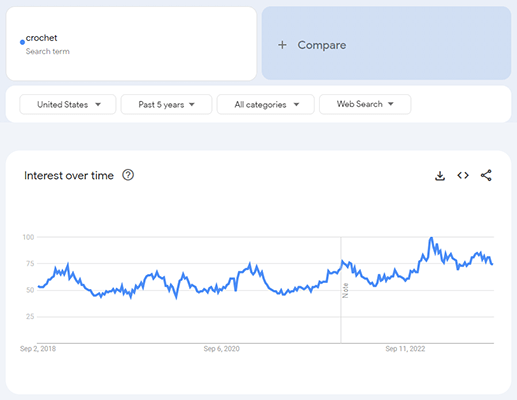
Be sure to also select the region you plan on targeting if yours isn’t selected by default.
The 12-month filter will let you see if each niche idea is seasonal or if interest is consistent throughout the year.
The five-year filter will let you know if each idea is newly popular and, therefore, likely to die out eventually, or if interest has been consistently decent for quite some time.
Use your best judgment to determine if each niche idea has enough interest for you as well as if you’re prepared to deal with certain ideas only popular during certain times of the year.
7. Choose a niche.
You should have enough data to make a final decision by now.
Choose a niche that receives attention in search engines and on social media and doesn’t seem too competitive.
Above all, choose a niche that interests you.
You’re going to have to create a lot of content for this niche to properly market it, so it’s best to choose an idea that’s least likely to lose your interest as time goes on.
3. Conduct market research
Conducting market research is an important step in starting a dropshipping business.
It gives you the opportunity to make an informed business decision as far as choosing your first products go.
Without this research, you’d need to pick products based on what seems to be the best, throw them at the wall and hope something sticks.
We’re going to show you how to conduct market research by breaking it down into the following steps:
- Identify the markets within your niche.
- Identify products and prices.
- Identify your competitors.
3.1 Identifying markets within your niche
A “target market” or “target audience” can mean many different things, especially when it comes to ecommerce.
Officially, it means individuals who are most likely to buy your products.
However, identifying who those individuals are is what’s so tricky.
Target markets can be something as simple as the primary demographics that make up a niche or something as elaborate as the subgroups within a niche.
Subgroups for the crochet niche include skill-based groups like beginners, intermediate and experienced crocheters as well as type-based groups like crocheting plushies, blankets, clothing, etc.
An easy way to determine demographics for a niche is by using a tool like Similarweb.
Search for your niche on Google, and look for a few sites that seem to be dedicated specifically to that niche.
Then, input one of the sites into Similarweb, and scroll down to the Audience section.
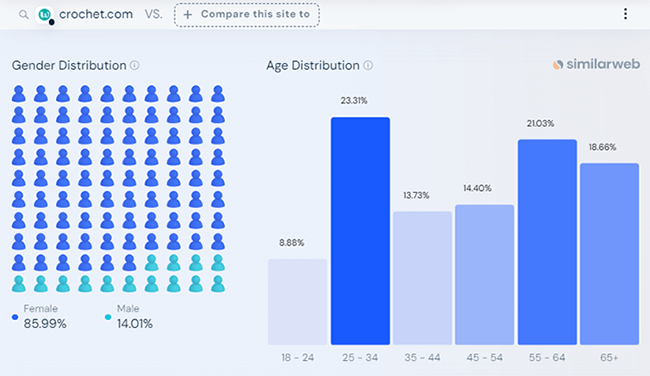
You’ll find gender and age-based demographics here.
Do the same for the other sites, and you should have a pretty good idea of the sorts of people who make up your niche.
Pick one market or combine a few to be your target market.
For example, based on research, popular demographics for the crochet niche are women between the ages of 25 and 34.
Therefore, a good target market for the crochet niche are experienced female crocheters between the ages of 25 and 34 as members of this group are most likely to become repeat customers.
This is because the 18-49 age range has long been thought of as being the most active among consumer age groups.
3.2 Identifying products and prices within your niche
This step is similar to the research you did earlier while you were picking a niche. Now, you can take your research a few steps further by identifying more potential products you can sell.
You do this by identifying key products that are sold within your niche as well as common prices for them.
AliExpress and Amazon are great places to start, particularly because they have a lot of data for you to work.
Simply entering your niche into Amazon’s search bar is a great way to generate product ideas as the ecommerce platform’s autofill feature does the work for you.
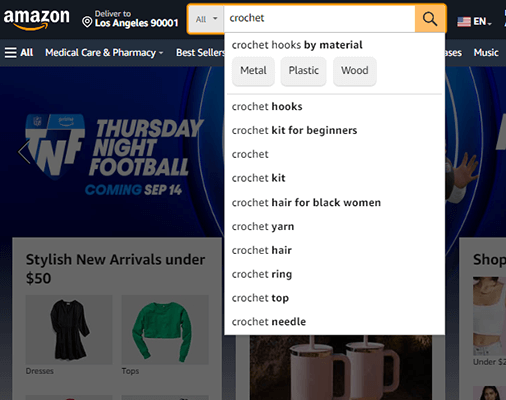
You can also hit enter and spend a bit of time browsing Amazon and AliExpress to see what sort of products show up.
As you browse, keep an eye on metrics that state the number of units sold for each individual product, average ratings for each product and how many reviews each product has.
You’ll have a pretty good indicator of how each product type performs the longer you browse.
3.3 Identifying your competitors
Once you’re pretty sure of the various product niches within your niche, find a few competitors, and see if your results check out with what your competitors are actually selling and how much they’re asking for.
You can also use this method to find products.
Here’s how to do it: search for a product type in Google, and add the phrase “for sale” to your query.
For example, search for “crochet hooks for sale” instead of “crochet hooks”.
You’re more likely to see search results for ecommerce stores this way.
When you simply search for “crochet hooks”, you’ll also see results for list posts and reviews of the best crochet hooks, which aren’t as helpful as these types of posts typically have affiliate links for Amazon and larger stores.
Speaking of which, as you browse Google, look for smaller ecommerce stores dedicated to your niche as opposed to big names.
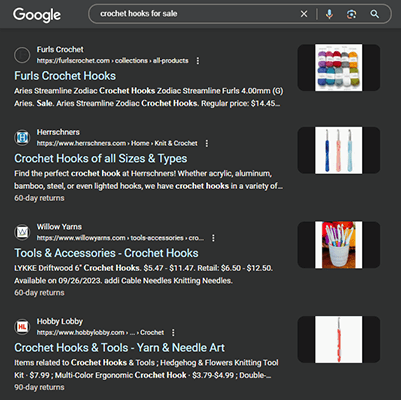
Once you find a few smaller stores, including fellow dropshipping businesses, that aren’t as well known, browse them to see what types of products they sell and what their prices are set at.
Browse their homepages in particular, and see what menu items they use to see which products your competitors perceive as being the most important in your niche.
4. Come up with your first product idea
You’ve already done the hard portion of this step: researching your niche and gathering data.
Now, it’s time to pick a product to get started with.
Feel free to pick more than one product from the start, especially if your niche requires more than one product type.
For example, crochet hooks aren’t useful without yarn or some type of thread to use them with.
Review each product type’s data in terms of keyword search volume and interest on Google Trends.
Then, consider how many results each product idea had on Amazon and AliExpress, how many items were sold per listing, and how many reviews each listing received.
What you’re looking for is a product that has a high level of demand but is not well targeted by your competitors.
If your niche doesn’t seem to be competitive in the first place, go ahead and target the product type that has the highest amount of interest.
For more insight, check out our list of the best dropshipping products to sell.
What to do if every product is too competitive
If the main product types in your niche seem too competitive, go back to AliExpress, and enter your niche into the search bar.
Click the Orders filter to sort the results by number of units sold per listing.
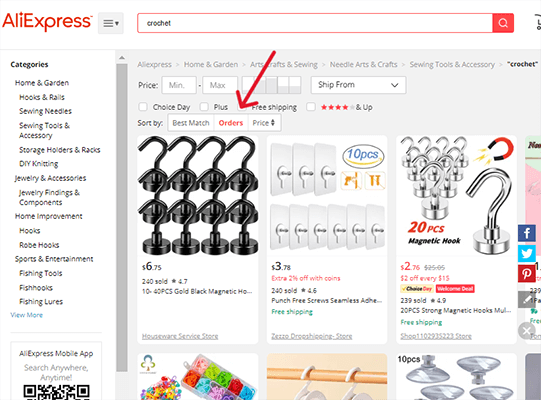
Then, browse page by page until you find a product that seems unique enough to target.
For example, “crochet hooks” and “crochet hook set” are far too competitive on a platform like Amazon.
However, we were able to find a few wooden crochet hooks on AliExpress, and when we entered “wooden crochet hooks” into Amazon’s search bar, we didn’t find nearly as much variety as “crochet hooks” has.
If you truly can’t find a unique enough product to target, consider how popular the niche is on social media, YouTube and search engines.
If it’s not too popular and competitive outside of Amazon, you may be able to outperform your competitors in sales by first outperforming them in content.
To reiterate points we made earlier, to determine how competitive a niche is, consider:
- Its search volume and keyword difficulty score by researching it in a keyword research tool.
- How much content and social media profiles are dedicated to your niche on key social media channels, especially TikTok, YouTube and Instagram.
- Also, consider how many likes, views and followers that content and those content creators have.
This data will let you know if your niche is worth marketing with content as opposed to trying to outsell competitors on Amazon and ad listings.
We’re covering how to get a dropshipping store up and running next, so if you don’t have your product idea, yet, go ahead and spend a little more time with the beginning portions of this article to try and find one.
5. Choose an ecommerce platform
One of the most important aspects of learning how to start a dropshipping business is choosing an ecommerce platform.
Sure, you could develop an ecommerce website from scratch or even hire a developer to build one for you, but this is far too complicated and expensive for a new business venture, especially when dedicated ecommerce platforms exist.
We recommend Shopify.
It powers 26% of all ecommerce stores and is used by Kylie Jenner, Jungalow, Crate & Barrel, Rebecca Minkoff, Gymshark, Brooklinen, and more.
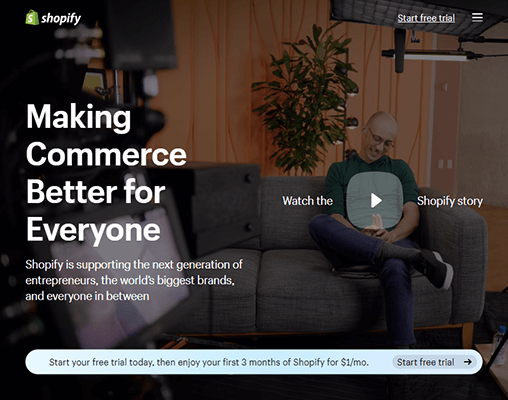
The platform is affordable and comes with hosting, website templates and even dropshipping apps for you to use.
It’s also incredibly easy to navigate, allowing you to get a shop up and running within the hour without having to touch a lick of code.
Best of all, you can get started with a free trial.
All you need to do is enter your email address.

Note: Shopify’s promotional offers are subject to change. Current deals may not reflect what’s represented in this image.
There’s a brief onboarding quiz for you to fill out. You can skip it if you want, but it’s a great way for Shopify to get everything ready for you based on your individual needs.
For the purposes of this tutorial, here’s how we filled everything out:
- Question 1: I’m just starting.
- Question 2: An online store.
- Question 3: Dropshipping products.
- Question 4: Choose your location.
Lastly, choose how you want to log into Shopify. We recommend using your email address so that logging into your merchant account is not dependent on a third-party platform.
Your free trial only lasts a few days, at which point you’ll need to pick a plan. The Basic plan works just fine for a new dropshipping store with one or two team members managing the account.
What to do next
Building a Shopify store is a whole ‘nother topic.
Here’s a quick list of everything else you still need to take care of outside of setting up dropshipping:
- Choose a template.
- Build key pages.
- Homepage.
- Shop page.
- About page.
- Contact page.
- FAQ page.
- Policy/terms and conditions pages.
- Choose colors to represent your brand, and design the rest of your website.
- Create and add your logo to your site’s header.
- Create a menu that includes your key pages.
- Create a domain name, and use it to replace Shopify’s default domain.
- Bonus: Set up email marketing and social sharing.
Fortunately, you don’t need to do all of this before Step 6, so feel free to continue with our tutorial for now.
6. Choose a dropshipping app
The easiest way to dropship with Shopify is by using a dedicated dropshipping app that integrates with the platform.
We recommend Spocket.
Spocket is a dropshipping app that integrates with a variety of different platforms, including Shopify.
It allows you to connect your store to dropshipping suppliers who store inventory and fulfill orders on your behalf.
It even comes with a free trial and is quite affordable.
Like Shopify, just enter your email address to get started.
Skip all of the onboarding process, then go to My Store, enter your Shopify URL, and click Connect.
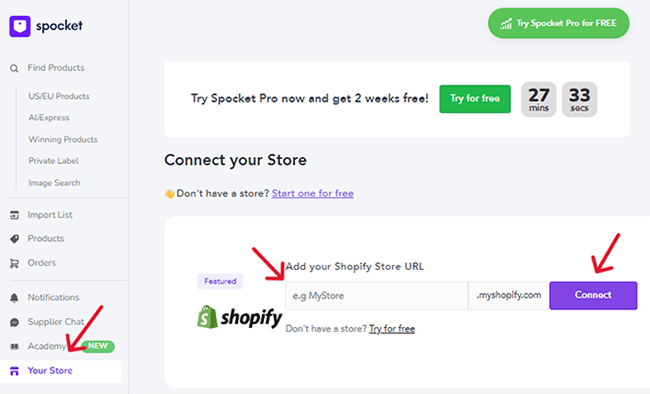
You’ll then need to select your Shopify account, and click Install App to complete the integration.
Note: To find your Shopify URL, click Settings in the lower, left-hand corner, then Domains. In the trial version, your URL will look like genericdomain.myshopify.com. Copy and paste everything before “.myshopify.com” in Spocket.
Importing products from Spocket
Next, find the product type you want to sell by searching for it in Spocket.
If you click on a product, you’ll notice a few different options:
- Add to Import List – This adds the product to a list of products you eventually want to import into your Shopify store.
- Open Product Variations – This option lets you view other colors/finishes/materials the product is available in.
- Order Samples – An option you can use to buy a sample of the product for testing purposes. It’s a great way to validate quality.
Here are other details you’ll find:
- Listing Price – The price you’ll pay when someone orders the product from your shop.
- Retail Price – The price Spocket recommends setting the price to in your store.
- Processing Time – Amount of time it takes for the supplier to get the product ready for shipping.
- Shipping Time – How long it takes for the product to ship to your chosen region.
- Return Policy – The terms and conditions the supplier uses for returns. This also becomes the return policy your customer will need to adhere to as you have no control over this process as a dropshipper.
Click Add to Import list on products you want to import into your Shopify store.
What if you can’t find your product type in Spocket?
If Spocket doesn’t offer the product you want to sell by default, you’ll need to import it into Spocket from AliExpress and eventually to Shopify instead.
Just click the AliExpress menu item in Spocket. This tab contains a button that takes you to a browser extension called AliScraper.
With AliScraper, you can browse AliExpress and import products you find there into Spocket.
Just be sure to keep an eye on your notifications within Spocket. They’ll let you know when imports fail.
When this happens, it’s best to find a different listing to import.
Successful imports will appear in your Import List.
Importing products into Shopify
When you’re ready to import products into Shopify, browse your import list in Spocket.
Then, click the Push to Store button associated with the product you want to import.
Alternatively, use the Push All button to import all products on your list into Shopify.
7. Get your ecommerce store ready
Once you import all of the products you want to import into Shopify, set prices for them, and create product pages for each.
You should also complete each step we mentioned earlier.
As you set prices, consider shipping costs and whether or not a customer will pay sales tax when the customer purchases something as well as what your profit margins should be.
Dropshipping profit margins go as low as 10% to as high as 40%.
Take a look at your competitors’ prices and profit margins if you’re not sure.
8. Take care of additional tasks required for new businesses
As a new online business, there’s still quite a few additional tasks you’ll need to take care of:
- Choose a business structure.
- Request an EIN.
- Determine how to handle your finances.
- Determine if you need a loan.
- Familiarize yourself with tax laws.
- Determine if you need a business license.
For business structures, it’s best to form an LLC for your new dropshipping business as it provides personal liability protection.
This means if a customer wants to sue for whatever reason, they have to go after your ecommerce business rather than your own personal finances.
Essentially, an LLC allows you to place a divide between your personal and business finances.
Furthermore, it allows you to pay less taxes. While the business is still taxed, you’ll pay yourself a salary and pay income taxes on that salary.
This is much cheaper than paying self-employment taxes on all revenue you generate from your dropshipping store.
All other items on that list are just as important, so be sure to take your time with all of them.
9. Launch your store
After you launch your store, be mindful of the following additional tasks:
- Marketing your products and your brand.
- Tracking analytics in Shopify and your website as a whole.
- Improving and adapting on every aspect of your business as needed.
For marketing, your research will tell you which social media platforms your audience hangs out on the most.
Create content optimized for each platform.
Shopify has built-in reports and analytics that let you track sales performance, but you should also track website and campaign performance in Google Analytics or an alternative like Matomo.
You should also be mindful of analytics within each social media platform you use as well.
The greatest benefit the data these analytics tools provide is the ability to see which products perform the best, which ones need a little help and which campaigns are most effective.
Final thoughts
That concludes our tutorial on how to start a dropshipping business.
As you can see, picking out a niche is the most important aspect of starting a dropshipping niche.
It’ll influence the types of products you sell, how easily you’re able to sell those products as well as how you market those products.
Other important aspects of starting your own dropshipping business are choosing an ecommerce platform as well as a dropshipping app to use.
Again, we recommend using a Shopify + Spocket combo as both allow you to get started with dropshipping and ecommerce as a whole without hassle, making it much easier for you to start a successful dropshipping business.
Related reading:
Disclosure: Our content is reader-supported. If you click on certain links we may make a commission.

